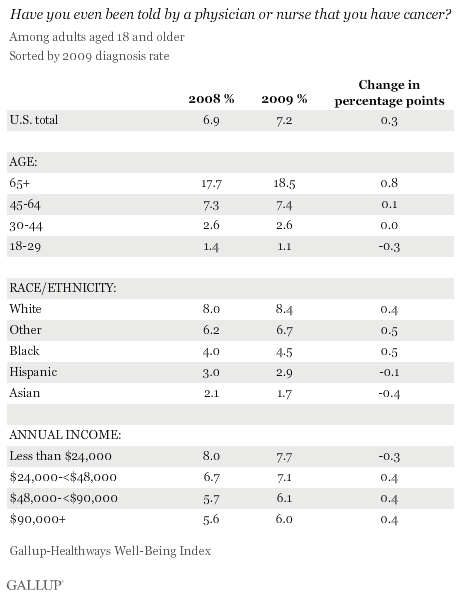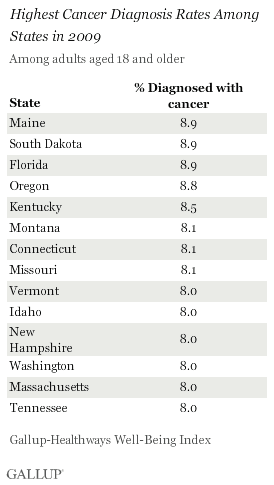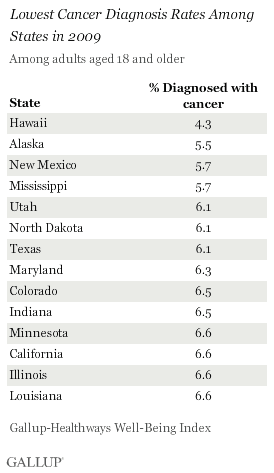WASHINGTON, D.C. -- Slightly more Americans were living with a cancer diagnosis in 2009 than were in 2008, according to Gallup-Healthways Well-Being Index data. The nationwide increase of 0.3 percentage points represents approximately 690,000 additional adults with diagnosed with cancer than the year before.

Among major demographic groups, Americans 65 and older reported the largest uptick in cancer diagnoses, from 17.7% in 2008 to 18.5% in 2009 -- easily dwarfing all other age groups.
Among major racial/ethnic groups, cancer diagnoses are substantially higher among whites than among other groups. Lower income Americans are also somewhat more likely to have been diagnosed with cancer than their higher income counterparts.
Maine, South Dakota, and Florida Have Highest Cancer Diagnosis Rates; Hawaii the Lowest
Despite the slight increase in cancer diagnoses nationwide, rates vary by state. People in Maine, South Dakota, and Florida are more than twice as likely to report having been diagnosed with cancer than those in Hawaii. In total, 14 states have a cancer diagnosis rate of at least 8%, while Alaska, New Mexico, and Mississippi join Hawaii as the only states with cancer diagnosis rates of less than 6%. States with higher than average percentages of seniors, such as Florida and South Dakota, will be more likely to sustain higher cancer rates.


See all states on page 2.
Implications
It is possible that to some degree improving cancer survival rates influence the increase in the measured cancer diagnosis rate, although determining the extent of this affect is extremely difficult. Ever earlier detection via aggressive screening, too, can result in a net increase in the percentage of Americans living with a cancer diagnosis, although this doesn't necessarily reflect an authentic increase in those that actually have it. As improvements in early detection and subsequent survival rates across all cancers collectively occur slowly over time, it seems likely, therefore, that both of these factors will at most have a small impact on the rate of cancer incidence in year-over-year measurement.
Learn more about the Gallup-Healthways Wellbeing Index.
Survey Methods
Results are based on telephone interviews with more than 350,000 national adults (aged 18 and older) each year, conducted between Jan. 2-Dec. 30, 2008, and Jan. 2-Dec. 29, 2009. The reported 0.3 percentage point increase in cancer diagnosis is statistically significant with 95% confidence.
For annual results based on the stated total sample of national adults, one can say with 95% confidence that the maximum margin of sampling error is ±0.2 percentage points. The margin of sampling error for most states is ±1-2 percentage points, but is as high as ±3.5 percentage points for smaller states such as South Dakota and Hawaii.
Interviews are conducted with respondents on landline telephones (for respondents with a landline telephone) and cellular phones (for respondents who are cell phone only and cell phone mostly).
In addition to sampling error, question wording and practical difficulties in conducting surveys can introduce error or bias into the findings of public opinion polls.
About the Gallup-Healthways Well-Being Index™
The Gallup-Healthways Well-Being Index measures the daily pulse of U.S. wellbeing and provides best-in-class solutions for a healthier world. To learn more, please visit well-beingindex.com.

